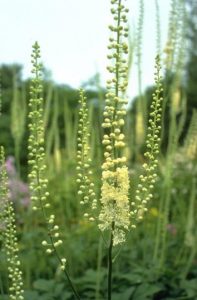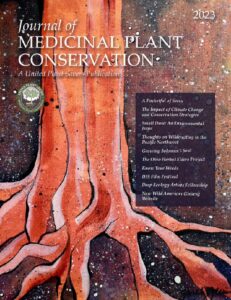Overall At-Risk Score: 40
Latin Name:
Actaea racemosa
Synonyms: Actaea ramosa, and Cimicifuga ramosa
Common Name:
Black Cohosh; Black Bugbane, Black Snakeroot, Fairy Candle
Family:
Ranunculaceae (Buttercup family)
Lifespan:
Perennial
Reproduction:
Black cohosh plants are monoecious, with long white spikes covered in flowers that can grow several feet in height, and are pollinated primarily by butterflies and bees. The seeds from the black cohosh are dormant until they go through a warm-cold-warm dormancy cycle that, depending on weather conditions, can last anywhere from 6 months to two years before germination is completed.
Geographic Region:
Black cohosh can be found from Southern Ontario and Quebec in the north down to Alabama and Georgia in the south. Specifically, it lives in the U.S. states of Alabama, Arkansas, Connecticut, Delaware, Georgia, Illinois, Indiana, Iowa, Kentucky, Maine, Maryland, Massachusetts, Michigan, Mississippi, Missouri, New Jersey, New York, North Carolina, Ohio, Pennsylvania, South Carolina, Tennessee, Virginia, and West Virginia. In Canada, it can be found in Ontario and Quebec.
Habitat:
Black cohosh prefers moist, humus-rich soils and rich forests with part to full shade.
Vulnerability of Habitat/Changes of Habitat Quality and Availability:
Development and logging in the Eastern Hardwood region have been known to weaken or entirely remove groups of black cohosh, and may soon become a threat to the genetic diversity of the species.
Ability to Withstand Disturbance and Overharvest:
The parts primarily harvested from black cohosh are the rhizomes and root system, and often times the entire plant is dug up to access them. This combined with the slow germination and establishment time leads to black cohosh populations being slow to regenerate after being overharvested.
Status of Endangered/Threatened(by state):
Actaea racemosa is listed as “Endangered” in both Illinois and Massachusetts
Actaea racemosa has not yet been evaluated by the IUCN Red List
Part of Plant Used/Active Medicinal Compounds:
The roots of black cohosh were used historically by Native Americans primarily for rheumatism, but it was also believed to have helped with kidney issues, as well as coughs and the common cold.
Demand:
The annual harvest of black cohosh can equate to as much as 500,000 pounds in dry weight per year, an estimated 97% of which is wild-harvested.
Wild Harvesting Impact On Other Species:
The large demand for black cohosh has led to the accidental harvest of other plants in the Actaea genus, all of which have some legal protections in place for them. Plants particularly at risk for this exist in the same or similar regions as black cohosh and include:
Mountain bugbane (A. podocarpa), which is “Endangered” in Illinois and “Rare” in Pennsylvania,
White baneberry (A. pachypoda), which is listed as “Exploitably Vulnerable” in New York and “Endangered” in Florida, and
Appalachian bugbane (A. rubifolia), which is “Threatened” in Illinois, Kentucky, and Tennessee, and “Endangered” in Indiana.
All of these face their own threats as far as wild-harvest and habitat loss, but these issues are only exacerbated by misidentification on the part of beginner herbalists and irresponsible wild-harvesters.
Recommendations For Industrial and Home Use:
Black cohosh is easily cultivated and can be grown both from seed and rhizome cuttings, and despite preferring shady regions, it can easily grow in part or full-sun if grown properly. Some alternatives suggested by natural medicine practitioners include pulsatilla, motherwort, and chaste berries. Please talk to your doctor before attempting to take Actaea racemosa or any other medicinal plant.
Citations
- Chandler, R. Frank, Lois Freeman and Shirley N. Hooper, 1979, Herbal Remedies of the Maritime Indians, Journal of Ethnopharmacology 1:49-68, page 56
- Duke, J. and Foster, S., (1990), A Field Guide to Medicinal Plants and Herbs: Eastern and Central North America, Boston MA, Houghton Mifflin, Page 56.
- Hamel, Paul B. and Mary U. Chiltoskey, 1975, Cherokee Plants and Their Uses — A 400 Year History, Sylva, N.C. Herald Publishing Co., page 30
- Herrick, James William, 1977, Iroquois Medical Botany, State University of New York, Albany, PhD Thesis, page 320
- Integrated Taxonomic Information System, (n.d.), ITIS Standard Report Page: Ligusticum porteri, Retrieved from https://www.itis.gov/servlet/SingleRpt/SingleRpt?search_topic=TSN&search_value=821148
- Lady Bird Johnson Wildflower Center, (2007, January 01). Plant Database: Actaea racemosa var. racemosa, Retrieved August 26, 2019, from https://www.wildflower.org/plants/result.php?id_plant=ACRAR
- Small, C. J. et al., 2011, Recovery of Black Cohosh (Actaea racemosa L.) Following Experimental Harvests, The American Midland Naturalist, 166(2), 339-348
- Speck, Frank G., 1917, Medicine Practices of the Northeastern Algonquians, Proceedings of the 19th International Congress of Americanists Pp. 303-321, page 310311
- USDA. (n.d.). Plants Profile for Actaea (baneberry). Results compiled from multiple publications. Retrieved August 6, 2019, from https://plants.usda.gov/core/profile?symbol=ACTAE
- Witthoft, John, 1947, An Early Cherokee Ethnobotanical Note, Journal of the Washington Academy of Sciences 37(3):73-75, page 73, 74
Related Posts
Salvation for Medicinal Herbs
Salvation for Medicinal Herbs Ute Eberle und Susi Lotz Text | Katharina Poblotzki Fotos They reappear shortly after the last snow has thawed …
Endangered Plants and Women’s Health: Fertility Herbs At Risk
Written by Susan Leopold, PhD for Herbal Reality. It was early this spring in 2021 when visiting a friend in southern Virginia that I came across a …







